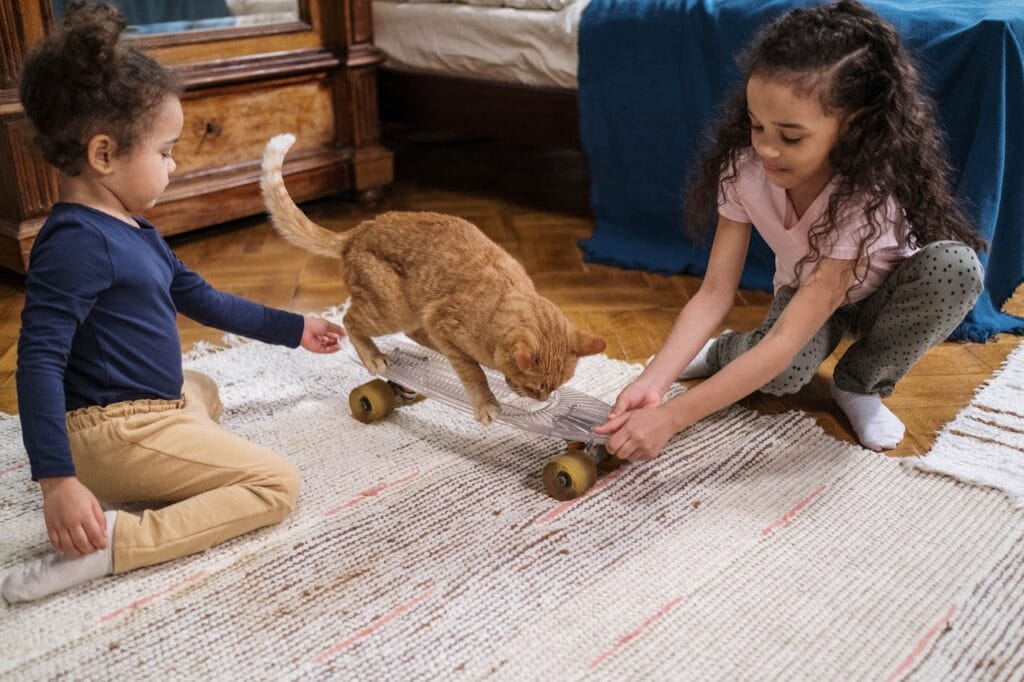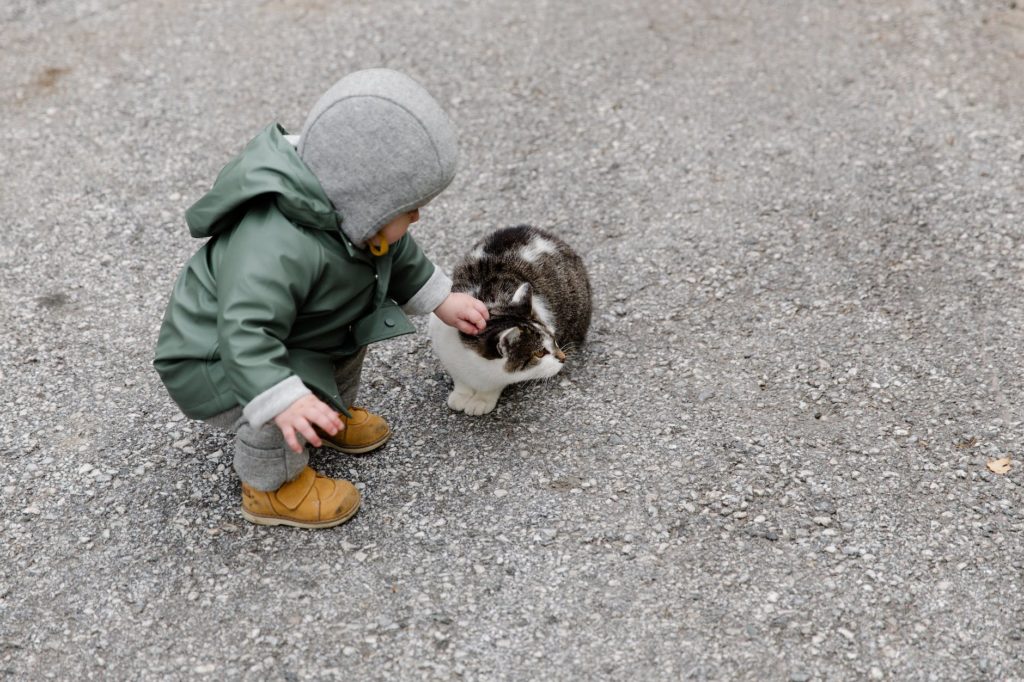Mix Cats And Kids The Right Way
As a pet owner and a parent, successfully integrating cats and children into a harmonious household requires careful consideration and proactive measures. Cats and kids can coexist happily together, but it’s essential to understand both their needs and behaviors to ensure their safety and well-being. In this extensive guide, we’ll delve deeper into various aspects of mixing cats and kids, providing comprehensive advice and strategies for creating a positive environment for all.

Table of Contents
Educate Your Children About Cats: your Cats And Kids
Educating your children about cats is crucial for fostering a respectful and safe relationship between them. Cats And Kids. Here are detailed strategies for teaching children about cat behavior and care:
- Approaching Cats: Teach children to approach cats calmly and gently, avoiding sudden movements or loud noises that may startle them. Demonstrating the correct way to approach a cat by extending a hand for them to sniff can help children understand how to initiate contact safely for the cats and kids.
- Handling: Show children how to handle cats gently, supporting their bodies and avoiding rough play. Emphasize the importance of respecting a cat’s personal space and allowing them to come to the child for interaction rather than forcing attention.
- Understanding Cat Signals: Educate children about common cat body language signals, such as flattened ears, twitching tail, or dilated pupils, which indicate when a cat is feeling fearful, anxious, or defensive. Teaching children to recognize these signs helps prevent accidental scratches or bites between the cats and kids
- No Tail or Ear Pulling: Stress the importance of never pulling a cat’s tail or ears, as this can cause pain and provoke a defensive reaction from the cat. Encourage gentle petting on areas where cats enjoy being touched, such as the head or chin for the cats and kids.
- Respect for Safe Spaces: Explain to children that cats and kids need their own space where they can retreat when they feel overwhelmed or tired. For the cats and kids, designate specific areas in your home as “cat-safe zones” where children know not to disturb the cat.
- Interactive Learning: Use interactive methods to educate children about cats, such as reading age-appropriate books about cat behavior or watching educational videos together. Engage children in discussions about what they’ve learned and encourage questions to promote understanding.
- Handling New Situations: Teach children how to introduce cats and kids to new situations or environments calmly and gradually. Explain the importance of allowing the cat to explore at their own pace and respecting their need for adjustment time. For example, when bringing home a new toy or rearranging furniture, involve children in creating a calm and welcoming atmosphere for the cats and kids.
- Recognizing Stress Signs: Educate children about subtle signs of stress or discomfort in cats, such as excessive grooming, hiding, or changes in appetite. Help children understand that these behaviors may indicate that the cat needs space or quiet time to relax. Encourage them to observe and respect these signals to maintain a positive relationship with the cat.
- Importance of Consistency: Emphasize the importance of consistency in caring for cats, including feeding schedules, grooming routines, and playtime activities. Teach children that cats thrive on predictable routines and feel more secure when their daily needs are met consistently. Encourage children to participate in daily care tasks as a way to bond with the cat and promote a sense of responsibility.
Supervision and Interaction
Supervising children’s interactions with cats is essential to prevent misunderstandings and ensure safety for both parties. Here are more strategies for effective supervision and interaction for Cats And Kids:
- Always Supervise: Never leave young children unsupervised with a cat, even if the cat is known to be gentle. Children may inadvertently mishandle or frighten the cat, leading to defensive behaviors.
- Teach Gentle Play: Encourage gentle play interactions, such as using wand toys or laser pointers, that allow children to engage with the cat from a safe distance. Discourage rough play or chasing behaviors that may agitate the cats and kids.
- Intervene Appropriately: If a child or the cat becomes overly excited or agitated during play, calmly separate them and redirect their attention to a different activity. Avoid yelling or sudden movements that may escalate the situation.
- Set Boundaries: Establish clear boundaries for interactions, such as not disturbing the cat while they’re eating or sleeping. Teach children to approach the cat quietly and respectfully, especially during these times for the cats and kids.
- Teaching Respect for Personal Space: Educate children about the importance of respecting a cat’s personal space, especially when the cat is resting or eating. Teach them to approach the cat calmly and quietly, avoiding sudden movements or loud noises that may startle the cat. Encourage children to observe from a distance if the cat appears sleepy or withdrawn, respecting their need for uninterrupted rest.
- Handling Cat Toys and Accessories: Show children how to handle cat toys and accessories safely and responsibly. Teach them to pick up toys and play items gently, avoiding rough handling that could damage the toys or potentially harm the cat. Emphasize the importance of returning toys to designated storage areas after playtime to prevent accidents or clutter that may stress the cat.
- Understanding Play Cues: Help children understand and interpret a cat’s play cues to promote positive and engaging interactions. Teach them to recognize when a cat is in a playful mood, such as chirping, swatting at toys, or crouching low to the ground. Encourage children to engage in interactive play sessions using appropriate toys, such as feather wands or interactive puzzles, that stimulate the cat’s natural hunting instincts and provide mental stimulation. The cats and kids will have great relations
Creating Safe Spaces for Cats And Kids
Cats thrive in environments where they feel secure and in control. Providing designated safe spaces for your cat helps reduce stress and promotes a harmonious household. Here are more strategies for creating safe spaces:
- Cat Trees and Perches: Install cat trees or wall-mounted perches that allow your cat to observe their surroundings from a height. Cats feel safer when they have an elevated vantage point where they can retreat if they feel threatened.
- Quiet Retreats: Designate a quiet room or corner of your home where your cat can retreat undisturbed. Place a comfortable bed, blankets, and toys in this area to create a cozy retreat for your cat.
- Hiding Places: Cats often appreciate hiding spots where they can retreat when they need privacy or solitude. Provide covered beds, cat caves, or cardboard boxes in quiet areas of your home where your cat can hide away comfortably. The cats and kids need to understand this.
- Interactive Feeding Stations: Create interactive feeding stations that stimulate your cat’s natural hunting instincts and encourage mental stimulation. Use puzzle feeders or food-dispensing toys that require your cat to work for their food, promoting physical activity and preventing boredom. Rotate different feeding stations throughout your home to provide variety and keep your cat mentally engaged.
- Comfortable Perches Near Windows: Place comfortable perches near windows where your cat can safely observe outdoor sights and sounds. Install window perches or secure shelves that offer a stable and comfortable vantage point for your cat to enjoy birdwatching or sunbathing. Ensure the perches are positioned away from potential hazards, such as blinds or curtains that could entangle your cat.
- Scent Enrichment Areas: Create scent enrichment areas where your cat can explore and interact with different scents in a safe and controlled environment. Use cat-safe herbs, such as catnip or valerian, to create scent trails or hide small amounts of dried herbs in interactive puzzle toys for your cat to discover. Scent enrichment encourages your cat’s natural curiosity and provides sensory stimulation that promotes mental and emotional well-being.
- Multi-Level Play Structures: Invest in multi-level play structures or climbing trees that offer various levels and platforms for your cat to explore and play. Choose sturdy and stable structures made from durable materials, such as sisal rope or carpet, that can withstand your cat’s scratching and climbing behaviors. Place the play structures in areas of your home where your cat spends the most time, such as near windows or in common living spaces, to encourage regular use and physical activity. Make cats and kids play together.

Teaching Your Cat to Use Scratchers
Scratching is a natural behavior for cats that helps them maintain their claws, mark their territory, and stretch their muscles. Teach the cats and kids. Encouraging your cat to use appropriate scratching surfaces prevents damage to furniture and promotes healthy scratching habits. Here are additional strategies:
- Introduce Scratching Posts: Place scratching posts or pads in areas where your cat spends time, such as near their favorite sleeping spots or along common pathways. Choose sturdy, stable scratchers that won’t tip over during use.
- Use Positive Reinforcement: Encourage your cat to use the scratching post by sprinkling catnip on it or placing treats nearby. Praise and reward your cat with treats or playtime whenever they use the scratching post, reinforcing the desired behavior.
- Discourage Furniture Scratching: If your cat starts scratching furniture, gently redirect them to the scratching post without scolding or punishing them. Consistency and patience are key to teaching your cat where it’s appropriate to scratch.
- Variety of Scratching Surfaces: Offer a variety of scratching surfaces to cater to your cat’s preferences. In addition to traditional vertical scratching posts, provide horizontal cardboard scratchers, sisal mats, or even tree bark outdoors (if safe and accessible). Cats may have individual preferences for scratching angles and textures, so providing options increases the likelihood of them using the designated scratchers.
- Regular Maintenance and Replacement: Inspect scratching posts and pads regularly to ensure they remain stable and appealing to your cat. Replace worn-out or frayed scratchers promptly to maintain their effectiveness and prevent your cat from seeking alternative scratching surfaces, such as furniture or carpets. Consider rotating different scratchers or repositioning them in new locations to keep your cat engaged and prevent boredom.
- Interactive Play and Exercise: Incorporate interactive play sessions using toys that encourage scratching behaviors, such as feather wands or dangling toys attached to scratching posts. Engage your cat in active play before meal times to satisfy their natural hunting instincts and encourage them to use the scratching post as part of their play routine. Regular exercise helps reduce stress and promotes overall well-being, making your cat more likely to engage in appropriate scratching behaviors. Get cats and kids play together.
- Cat-Safe Deterrents: Use cat-safe deterrents to discourage inappropriate scratching behaviors on furniture or other household items. Apply double-sided tape or a citrus-scented spray to areas where your cat tends to scratch inappropriately. Cats dislike sticky textures and strong odors, prompting them to seek out alternative scratching surfaces like designated scratchers. Ensure the deterrents are safe and non-toxic for your cat to avoid any adverse reactions.
Regular Vet Visits and Health Maintenance
Maintaining your cat’s health through regular veterinary care is essential for their well-being and behavior around children. Here are additional strategies:
- Schedule Routine Check-ups: Schedule annual veterinary exams to ensure your cat is up-to-date on vaccinations, parasite prevention, and overall health. Regular check-ups help detect and address any health issues early.
- Behavioral Consultations: If your cat exhibits behavioral concerns, such as aggression or anxiety around children, consult with your veterinarian or a certified animal behaviorist for guidance. They can recommend behavior modification techniques or medications if necessary.
- Health Monitoring: Monitor your cat’s health closely for any changes in behavior, appetite, or litter box habits. Cats may exhibit subtle signs of illness or discomfort that require prompt veterinary attention.
- Dental Care: Schedule regular dental check-ups and cleanings with your veterinarian to maintain your cat’s oral health. Dental disease is common in cats and can lead to pain, difficulty eating, and other health issues. Brush your cat’s teeth regularly at home using a cat-specific toothbrush and toothpaste recommended by your veterinarian. Dental treats or toys designed to promote dental health can also help reduce plaque and tartar buildup.
- Nutritional Counseling: Consult with your veterinarian to develop a tailored nutrition plan that meets your cat’s specific dietary needs and promotes overall health. Feed your cat a balanced diet formulated for their life stage, such as kitten, adult, or senior. Provide fresh water at all times and monitor your cat’s weight and body condition regularly to ensure they maintain a healthy weight. Avoid feeding your cat table scraps or human foods that may be harmful or lead to nutritional imbalances.
- Environmental Enrichment: Enhance your cat’s environment with enrichment activities and mental stimulation to promote physical and mental well-being. Provide interactive toys, puzzle feeders, and vertical climbing structures that encourage natural behaviors such as hunting, exploring, and scratching. Rotate toys and change the layout of their environment periodically to prevent boredom and stimulate your cat’s senses. Consider introducing indoor plants or cat-safe herbs for sensory enrichment, but ensure they are non-toxic to cats and placed out of reach.
Introducing Cats to New Situations Gradually
Introducing your cat to new environments or changes in routine, such as the arrival of a new baby or visiting children, should be done gradually to minimize stress:
- Slow Introductions: Introduce your cat to new situations gradually, allowing them time to acclimate at their own pace. For example, if expecting a baby, set up nursery furniture early and gradually introduce new scents associated with the baby. The cats and kids will have special bonding.
- Positive Associations: Create positive associations with new experiences by offering treats, praise, or playtime when your cats and kids interact calmly with children or new visitors. Avoid overwhelming your cat with sudden changes or loud noises.
- Provide Escape Routes: Ensure your cat has access to escape routes or hiding places during new experiences where they can retreat if they feel anxious or overwhelmed. Respect their need for space and allow them to observe from a distance initially.
Handling Accidental Scratches or Bites
Despite precautions, accidental scratches or bites may occur during interactions between cats and children. Here’s how to respond effectively:
- Clean the Wound: Immediately clean any scratches or bites with soap and water to reduce the risk of infection. Apply an antiseptic ointment and cover with a bandage if necessary.
- Monitor for Signs of Infection: Watch for signs of infection, such as redness, swelling, or discharge, around the wound. Consult a healthcare professional if symptoms worsen or if your child develops a fever.
- Address Fear or Anxiety: If a child becomes fearful of interacting with cats after an incident, offer reassurance and gradually reintroduce positive interactions under supervision. Encourage calm and gentle behavior around cats to rebuild confidence.
Teaching Responsibility and Empathy
Involving children in the care of your cats and kids teaches responsibility, empathy, and respect for animals:
- Feeding and Watering: Supervise children while they help with feeding and watering the cat, emphasizing the importance of consistency and reliability in caring for pets.
- Grooming and Play: Show older children how to groom the cat gently using a soft brush or comb. Engage children in interactive play sessions with the cats and kids using toys that encourage natural behaviors like hunting or pouncing.
- Respect Boundaries: Reinforce the importance of respecting the cat’s boundaries and signals, such as allowing them to initiate interactions or seeking privacy when needed.
Conclusion
Successfully mixing cats and kids requires patience, education, and proactive management of their interactions. By educating children about cat behavior, supervising their interactions, creating safe spaces for your cat, teaching them to use scratchers, scheduling regular vet visits, introducing cats to new situations gradually, and promoting responsibility and empathy, you can foster a positive relationship between your cat and children. Remember, each cat and child is unique, so adjust strategies accordingly to meet their individual needs and personalities. With proper guidance and understanding, cats and kids can thrive together in a loving and respectful environment.




